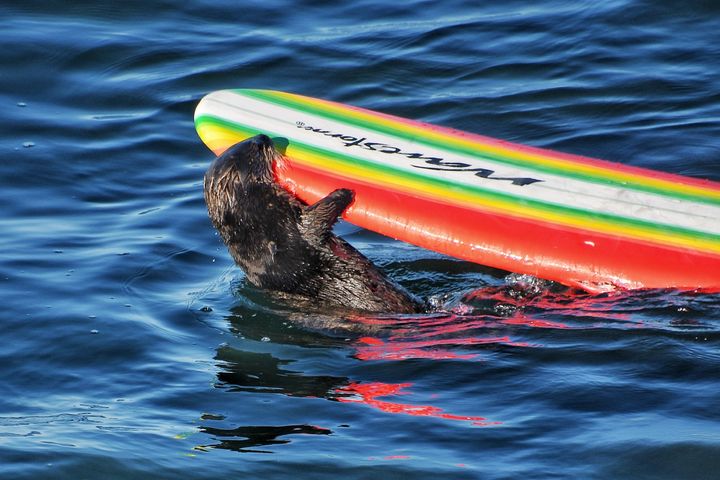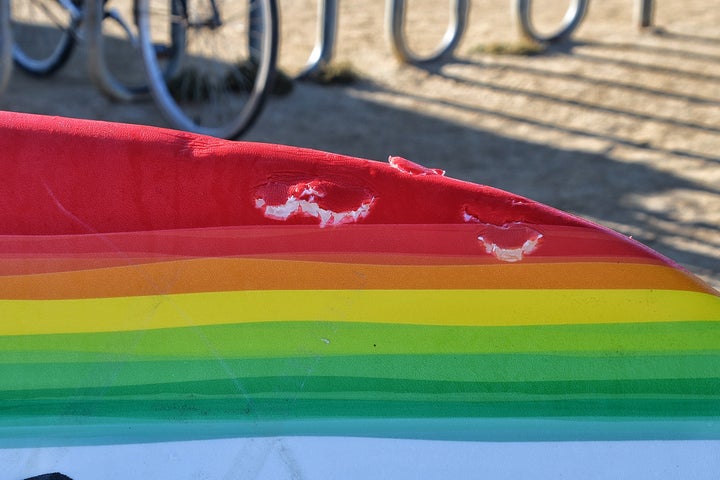A California sea otter with a penchant for snatching surfboards is on the lam after wildlife officials determined she’s putting herself and humans at risk.
She’s known as Otter 841. The now-5-year-old female began approaching surfers, kayakers and paddleboarders off the coast of Santa Cruz in 2021. Since then, she’s become bolder.

In a video taken last year, 841 can be seen climbing atop a surfboard in the water, then lunging at and chasing the surfer when he tries to get his board back. She also ripped a couple of chunks out of the board.
Last weekend, 841 was seen stealing surfboards three different times, The New York Times reported.
On Monday, the California Department of Fish and Wildlife announced that a group of experts would attempt “to capture and rehome” the otter, per the Times.
“A team from U.S. Fish and Wildlife Service, California Department of Fish and Wildlife, and Monterey Bay Aquarium are actively monitoring her and will continue to attempt capture when conditions are favourable in the coming days,” USFWS spokesperson Ashley McConnell told HuffPost in an email, adding that the animal “is tagged with a radio transmitter.”
Though 841′s “repeated aggressive behaviour” means that she will be placed in captivity, McConnell noted that USFWS is not looking at killing the otter as an option.
“I want to emphasise euthanasia is not under consideration,” she wrote.

How 841 picked up her thievery is unclear. “Hormonal surges” in female otters can lead to aggression, as can people feeding them, according to USFWS.
“We don’t know the cause of her behaviour... It’s potentially something we may never know,” Monterey Bay Aquarium spokesperson Kevin Connor told HuffPost. “But what we do know is that behaviour is not good for her. It’s not good for her survival in the wild.”
Connor understands why 841 has gained so many fans on social media. The idea of an otter stealing surfboards is “genuinely funny,” he said, but “it’s not going to be fun or entertaining if this escalates further.”

841′s mother had her own share of human trouble. That otter, known as 723, was a rescued orphan rehabilitated at the Monterey Bay Aquarium. Staff members go to great lengths to ensure that otters being prepared for release don’t associate “anything positive” with humans, Connor said. Caretakers wear black ponchos to hide their human form and avoid speaking around the creatures so they don’t get used to people’s voices.
723 was back in the wild for about a year before she began approaching kayakers and others, soliciting food. There was “clear evidence” that people had been feeding her, Connor said, and officials determined she had lost her fear of humans and would be better off living in captivity.
It turned out she was pregnant ― with 841. After 841 was weaned, she was prepared for and released to the wild. But like her mother, she started approaching humans after around a year.

Both situations demonstrate the importance of giving space to wildlife. People should never feed wild otters and should keep a safe distance, according to USFWS. On its website, the agency states that “if a sea otter notices you, you are likely too close and should back away.”
Respecting otters isn’t just about the well-being of the furry mammals themselves, but also the important role they play in the environment.
“They help keep the ocean and coastal ecosystems healthy and functioning,” Connor said. “They’re top predators. They’re the top of the food chain when they’re in their kelp forest or in an estuary. They balance those habitats.”
If 841 is captured, she’ll first undergo a health check at the Monterey Bay Aquarium, and will eventually be placed at an Association of Zoos and Aquariums-accredited aquarium or zoo.
As for her mother, she currently resides at the Aquarium of the Pacific in Long Beach, California.
“Her name’s Millie now,” Connor said. “Living her best life.”
